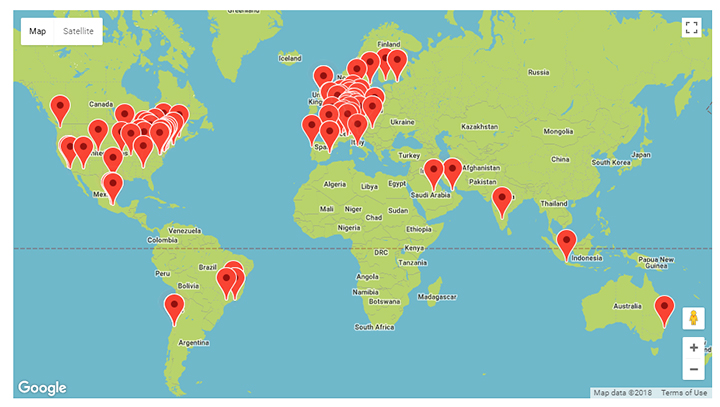Elizabeth Rosenzweig founded World Usability Day to raise awareness of user-centred design, and she hopes that one day it will become part of the United Nations official list of days.
Of course, every day is a great day to make products, services and systems (including websites) easier for everyone to use, including for people with specific accessibility needs. Still, it doesn’t hurt to have a day where we pay particular attention to how we can promote and implement usability, accessibility and inclusion.
What can we do today?
Every World Usability Day has a theme, and this year’s is “Design for good or evil”. The fact is, at its worst, bad design can prevent users from doing the things they want to do. It can even have fatal consequences. However, at its best, good design can save lives. Which camp your work falls into is a matter of research, empathy, testing, and technique – something we take very much to heart at Intopia, but applies no matter what field you work in.
The WUD website lists events taking place around the world in celebration and consideration of the theme.
For example, here in Sydney, Australia, uxRESEARCH Sydney is holding a meetup today from 5pm-9pm at the Commonwealth Bank Innovation Lab, with two speakers and a panel discussion – a great way to think and talk about this year’s theme.
Wherever you are in the world, there’s likely something happening near to you – find out more at the WUD events page.

What can we do EVERY day?
One area we focus on a great deal at Intopia is testing. It’s a core part of our work, and takes many forms. Possibly the most critical is the way we conduct usability testing with people with disabilities. This is where a product or service designer really finds out how usable and accessible their work is.
The resounding message is: test early, test respectfully, test collaboratively, test for accessibility – and test with a diverse range of participants. So what does this mean?
Test early
In the typical multi-step process of launching new products, services and systems, there is (usually) time factored in to test for security glitches and basic errors. After that’s all done, if at all, testing for usability or accessibility might get a look in – right at the very end. But you know what? Testing at the end of the development process creates problems: timeframes are tight, processes are set and changes can be costly.
It’s simply more efficient to test early, get real feedback, review and revise, and end up with a truly usable product or service. This can be as part of a co-designed process, or a standalone accessibility check that is built in.
So, instead of waiting until right before pressing the go button, test early, plan and budget for usability testing as you would with any scientific or iterative approach.
Test respectfully
Accounts have emerged of designers looking for congratulations, or a final sign off on how great their product or service is – rather than asking for potential suggestions or improvements. Humans don’t tend to like to be told they are wrong, or that their most beautiful animation is really distracting and inaccessible, or could cause a seizure … but it’s certainly better to be told that before you get taken to court.
Respect is the key to avoiding awkwardness for everyone involved. Respectfully requesting, recognising (and paying for) feedback is important. Intopia Connect provides paid opportunities for usability testing and this is crucial. Yes, it takes time to give, receive and incorporate feedback. Respect this time and effort. Rather than reaching out for validation, or coming up with “fixes” to something that you think might be a problem, test respectfully with an openness for good, bad, quirky feedback from diverse people with different perspectives.
Test collaboratively
Create opportunities for co-design or collaboration with end users including people with diverse disabilities. Better still, employ people with disabilities and diverse backgrounds and experiences to give you direct feedback and input through the design process. This doesn’t mean employing someone to be a professional full-time “tester” – it means hiring developers, designers and engineers with diverse backgrounds and disabilities.
Research means talking to real people, not just logging your system against a set of personas (although personas can also be helpful) to keep your assumptions in check.
Test for accessibility
At a recent meetup in Melbourne, Sarah Richards from Content Design London said “Accessibility is usability”.
You may or may not know about WCAG – the Web Content Accessibility Guidelines. WCAG is bread and butter for accessibility professionals, but the idea of conformance with dozens of WCAG 2.1 Level A and Level AA Success Criteria seems to daunt a lot of people, and that’s hardly surprising. Even so, WCAG provides a standardised framework for assessing accessibility, along with techniques for accessible solutions.
There are tools available for automated accessibility testing, and these definitely have their place. However, automated tools can’t replace manual, human testing – and they aren’t designed to – unless your end product or service is designed to be used only by machines (it’s not, is it?). Human accessibility experts who know where to look, what to look for, how to interpret what they find, and how to offer solutions to problems encountered.
Test with diversity
When undertaking usability testing, or to promote user-centred design, work with a diverse range of people with different ages, backgrounds, skills and abilities. When we undertake usability testing with people with disabilities, we deliberately use teams of people with a range of physical, sensory, cognitive and social disabilities. Yes, for our work, we practise diversity within disability – which is simply reflecting real life, isn’t it?
It’s not good enough to expect that if you test something with one person who uses a wheelchair, or one person who uses a screen reader, or one person who needs speech to be captioned, you somehow have accessibility covered. If that level of testing is not available to you, then call in the experts.
Whatever you do, don’t just shrug it off as being too hard. Testing is the key to perfecting the usability of your design and development work. Take it seriously, and make your choice: design for good or evil.

Happy World Usability Day.

